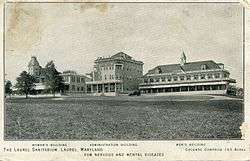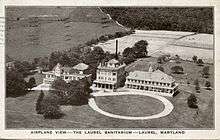Laurel Sanitarium
| Laurel Sanitarium for Nervous and Mental Diseases | |
|---|---|
 | |
| Coordinates | 39°05′10″N 76°51′53″W / 39.08611°N 76.86472°WCoordinates: 39°05′10″N 76°51′53″W / 39.08611°N 76.86472°W |
| Built | 1905 |
The Laurel Sanitarium for Nervous and Mental Diseases was a prominent sanitarium, and later a women's nursing home, and landmark building along U.S. Route 1 in Laurel, Maryland.[1] Sanitariums were common across the country from the late 1800s up to about the 1940s. Established by Dr. Jesse C. Coggins and Dr. Cornelius DeWeese to treat patients with mental illness and addiction,[2] it was started as a base for the Keeley Cure". One of the original buildings was the Gambrills Home (later the Brewster Park Hotel), moved to its Route 1 site from 5th Street, south of Montgomery Street in Laurel. The sanitarium opened in 1905 on 163 acres and housed 90 women patients, two full-time physicians and 42 employees in four main buildings and five cottages. Each guest occupied a private room, many with personal furnishings and family momentos, thereby creating a home-like setting.[3] Dr. Coggins was a proponent of families visiting patients at least once a week and by 1950 it had treated over 20,000 patients. Coggins believed that there was only one good treatment for alcoholics, Alcoholic's Anonymous. The facility ceased operations in September 1963 after the death of Coggins, and the historic structure was eventually demolished in August 1964 to make way for new housing and the Laurel Shopping Center.[4] It was demolished by controlled fire.

Coggins moved the building intact a half-mile to the long-standing site of the Laurel Sanitarium, in what was considered a major engineering feat. In 1914, a new building and annexes were constructed, bringing the building to its largest size. From 1950 until operations ceased in 1963, the sanitarium was operated as a 90-bed women's geriatric hospital.[1] When the facility closed on September 1, 1963, its 70 patients scattered to nearby rest homes and other institutions. Part of the grounds was sold to Prince George's County Board of Education and in 1965 became a new location for Laurel High School.[1]
Upon his death, Coggins willed his considerable fortune to the Keswick nursing home in Baltimore with a stipulation that the bequest be used to build a rehabilitation home for "whites-only". However, it was determined that the money would go to the University of Maryland Medical Systems as the will did not maintain the same racial clause to this alternative beneficiary.[5]
References
- 1 2 3 "Laurel Landmark Passes As New Community Is Planned On Site". Laurel Leader. August 27, 1964.
- ↑ Hurd, Henry Mills (ed.). "Laurel Sanitarium". The Institutional Care of the Insane in the United States and Canada. 2. 1916: Johns Hopkins Press. pp. 579–580.
- ↑ "Dr. Coggins,Laurel Sanitarium Celebrate 55 Years". Maryland State Medical Journal. April 1963.
- ↑ Barry, Dan (December 23, 2007). "A Place Just Like Every Other Place. Only Not.". The New York Times.
- ↑ "Keswick wins suit over will". Baltimore Sun. May 7, 2002.
